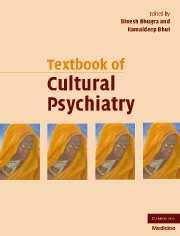Book contents
- Frontmatter
- Contents
- Contributors
- Foreword
- Preface
- Part I Theoretical background
- 1 Cultural psychiatry in historical perspective
- 2 Anthropology and psychiatry: the contemporary convergence
- 3 Suicide, violence and culture
- 4 Psychology and cultural psychiatry
- 5 Spirituality and cultural psychiatry
- 6 Culture, ethnicity and biological psychiatry
- 7 Ethnic inequalities and cultural capability framework in mental healthcare
- Part II Culture and mental health
- Part III Culture and mental disorders
- Part IV Theoretical aspects of management
- Part V Management with special groups
- Part VI Cultural research and training
- Cultural psychiatry: the past and the future
- Index
- References
3 - Suicide, violence and culture
from Part I - Theoretical background
Published online by Cambridge University Press: 11 August 2009
- Frontmatter
- Contents
- Contributors
- Foreword
- Preface
- Part I Theoretical background
- 1 Cultural psychiatry in historical perspective
- 2 Anthropology and psychiatry: the contemporary convergence
- 3 Suicide, violence and culture
- 4 Psychology and cultural psychiatry
- 5 Spirituality and cultural psychiatry
- 6 Culture, ethnicity and biological psychiatry
- 7 Ethnic inequalities and cultural capability framework in mental healthcare
- Part II Culture and mental health
- Part III Culture and mental disorders
- Part IV Theoretical aspects of management
- Part V Management with special groups
- Part VI Cultural research and training
- Cultural psychiatry: the past and the future
- Index
- References
Summary
EDITORS' INTRODUCTION
Suicide and violence are both culturally determined and influenced. There is considerable evidence that rates of suicide vary dramatically across nations, and cultures deal with these acts in different manners. The relationship between mental illness and suicide also varies. In some cultures, such as China and Sri Lanka, the rates of suicide are very high, but the rates of mental illness among those committing suicide are not. Social factors such as education, employment, high aspirations and poverty, along with stressors such as life events, may play a role. In some societies, the act of suicide remains illegal; therefore it is impossible to get accurate rates of suicide. Violence is related to a number of similar factors and globalization and urbanization may play an important role. Gender differences in suicide and violence vary too.
In this chapter, Tousignant and Laliberté propose that the national and gender differences in suicide and violence are culturally determined. Marital conflicts and relationship problems with in-laws are common causes of domestic violence and dowry deaths are sometimes passed off as suicide or accidental deaths. Embedded within these acts are the gender role and gender-role expectations. Using examples from aboriginal groups for rates of suicide and in Quebec, Tousignant and Laliberté suggest that drug or alcohol problems, along with problems in attachments and problems in relationships and breakdown of relationships, produce inordinate pressure on individuals, which is used as a trigger for seeking a way out. The sociocultural model these authors put forward is important in understanding vulnerability factors, which are more likely to be specific for specific groups.
- Type
- Chapter
- Information
- Textbook of Cultural Psychiatry , pp. 33 - 42Publisher: Cambridge University PressPrint publication year: 2007
References
- 1
- Cited by

